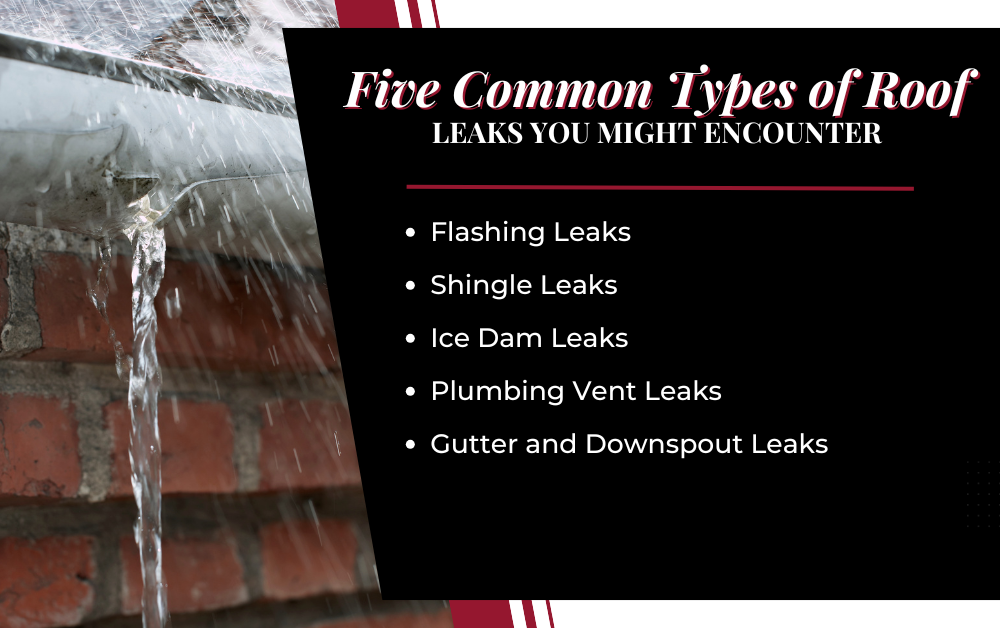Roof leaks can quickly turn into costly repairs if left unnoticed. They often start small but can cause serious damage to your home’s structure and interior. Knowing the common types of roof leaks helps homeowners act quickly and prevent further issues. At Dependable Roofing, we understand how important it is to catch these problems early. Our goal is to keep your roof secure and your home dry by helping you identify potential leak sources before they escalate. This guide will walk you through five typical roof leaks and what to do about them.
Flashing Leaks
Flashing holds a significant responsibility in securing your roof from water infiltration. It is installed around roof joints, chimneys, vents, and skylights to seal vulnerable spots. When flashing fails, water can enter where the roof’s surfaces meet, often causing leaks that are hard to detect initially. Over time, flashing can become cracked, corroded, or improperly sealed due to weather and wear. Flashing issues are a prevalent cause of leaks in roofs near penetrations. Prompt repairs or replacements can prevent water from seeping inside and causing extensive damage.
What Is Flashing?
Flashing comprises metal used for waterproof sealing joints and roof penetrations, acting as a barrier against water intrusion. It is typically made from aluminum or galvanized steel and shaped to fit tightly around roof features. The purpose of flashing is to direct water away from these weak points to prevent leaks. Properly installed flashing ensures that rainwater flows off the roof without penetrating vulnerable areas. When flashing deteriorates, it compromises this protective seal. Understanding its function highlights why maintaining flashing is critical for a leak-free roof.
How Flashing Causes Leaks
Flashing can develop cracks or rust due to constant exposure to rain, snow, and temperature changes. Sometimes, poor installation or damage from strong winds also causes flashing to loosen or separate from the roof. When flashing is compromised, water can easily enter gaps around chimneys, vents, or skylights. This infiltration can lead to leaks inside your attic or ceilings, which often manifest as water stains or mold growth. Since flashing leaks are frequently hidden behind roof materials, they can go unnoticed until serious damage occurs. Timely identification and repair are vital to protect your home.
Repairing Flashing Leaks
If you suspect flashing damage, it’s important to have a professional inspection as soon as possible. Repairing flashing involves sealing cracks, replacing rusty sections, or resealing joints to restore watertight protection. In some cases, entire flashing assemblies may need replacement to ensure long-term durability. Skilled roofing technicians use specialized tools and materials to perform these repairs effectively. Regular maintenance checks can extend flashing life and reduce the risk of leaks. Prompt attention to flashing problems is an investment that safeguards your roof and home.
Shingle Leaks
Shingles provide your roof’s first line of defense against the elements, but are vulnerable to damage from weather and age. When shingles crack, curl, or go missing, the protective barrier breaks down. This creates openings where water can penetrate the roof deck underneath. Shingle leaks often start small but can rapidly lead to structural issues in the roof and damage to the home’s ceilings. Identifying damaged shingles early and replacing them helps maintain the roof’s integrity.
The Role of Shingles
Shingles cover the roof surface and protect the underlying materials from rain, snow, and UV rays. They are designed to overlap in a way that sheds water efficiently. Asphalt shingles are the most common type, offering durability and weather resistance. Over time, shingles may wear down or become brittle due to sun exposure and harsh weather conditions. Maintaining healthy shingles is crucial to preventing moisture from entering your home. The condition of your shingles directly affects your roof’s performance and lifespan.
Causes of Shingle Leaks
Harsh weather, such as windstorms, hail, or heavy rain, can damage shingles by cracking or blowing them off entirely. Aging shingles naturally lose their flexibility and may start to curl or crack, creating gaps in the roof’s surface. Missing shingles expose the roof deck to water, which can lead to rot and leaks. Improper fitting or neglecting routine maintenance can also contribute to premature shingle failure. These problems usually cause localized leaks but can expand if not addressed quickly. Monitoring shingle condition helps homeowners avoid costly repairs later.
Addressing Shingle Leaks
Regular roof inspections help catch damaged or missing shingles before leaks develop. Replacing compromised shingles restores the protective layer and prevents water infiltration. Experienced roofers can evaluate the level of damage and recommend repair or replacement options. Timely shingle repair also improves your home’s curb appeal and energy efficiency. Maintaining your shingles is one of the most effective ways to extend your roof’s life. Always consult roofing experts like Dependable Roofing for quality service and peace of mind.
Ice Dam Leaks
Ice dams are a seasonal problem common in colder climates where snow accumulates on roofs. When snow partially melts and then freezes again at the roof border, it forms a barrier that blocks water drainage. As snow melts and subsequently refreezes near the edge of the roof, it can cause problems with the attic or the ceilings. Ice dam leaks often cause significant interior damage, including water stains, mold, and wood rot. Homes with poor attic insulation or ventilation are more susceptible to ice dams. It’s essential to apply precautionary measures to keep your roof safe from this invisible menace.
What Are Ice Dams?
Heat leakage from the attic melts snow, which contributes to ice dams on the roof surface. The melted water then runs down to the colder eaves, refreezing into a ridge of ice. This ice ridge blocks further meltwater from draining off the roof. Instead, water pools behind the dam and can seep under shingles or into roof vents. Ice dams can cause widespread water damage if not addressed quickly. Understanding how they form helps homeowners take steps to prevent them.
How Ice Dams Cause Leaks
Water trapped behind ice dams has nowhere to escape but underneath roofing materials. This backflow penetrates shingles, flashing, and insulation, leading to leaks inside your home. Ice dam leaks often appear as wet spots or stains on ceilings and walls. The constant moisture can promote mold growth and degrade structural components. Ice dams also accelerate roof wear and may require costly repairs if ignored. Early intervention is critical to minimize damage caused by ice dams.
Preventing Ice Dam Leaks
Proper attic insulation helps maintain a consistent roof temperature, reducing snowmelt. Efficient ventilation allows chilly air to circulate under the roofing system deck, preventing warm spots that cause ice dams. Adding insulation and sealing attic air leaks are effective prevention methods. Some homeowners also use heated cables or ice melt products to control ice buildup. Professional roof assessments can identify vulnerabilities and recommend customized solutions. Ice dam prevention is key to maintaining the integrity of your roof and home from unnecessary water damage.
Plumbing Vent Leaks
Plumbing vents facilitate the release of sewer gases from your home and usually pass through your roof. The areas where these pipes penetrate the roof are sealed with vent boots to prevent leaks. These rubber or plastic boots can degrade over time, becoming cracked or loose. When vent boots fail, water can easily enter the roofing system and cause leaks. Plumbing vent leaks often go unnoticed until they result in visible interior damage. Regular inspection and maintenance are necessary to keep vent seals intact.
What Are Plumbing Vent Boots?
Vent boots are flexible seals installed around plumbing vent pipes to waterproof the penetration points on your roof. They are typically made of rubber or plastic with a metal flashing base. The boots must fit snugly around the pipe and be securely fastened to the roof. Their main function is to prevent water from entering where the vent protrudes. Because vent boots are exposed to weather, they can dry out or crack over time. Maintaining vent boots is critical to avoiding roof leaks in these vulnerable areas.
Causes of Vent Boot Leaks
Exposure to sunlight and temperature fluctuations causes vent boots to become brittle and crack. High winds or roof movement may loosen the boot’s seal or cause gaps to form. Sometimes improper installation or age can lead to vent boot deterioration. When the seal fails, rainwater can infiltrate the roofing layers and attic space. Vent boot leaks are a frequent but often overlooked source of roof leaks. Early detection and repair prevent further water damage.
Maintaining Plumbing Vent Boots
Routine roof inspections should include a close check of plumbing vent boots for signs of wear or damage. Replacing cracked or loose boots promptly restores a watertight seal. Professional roofers have the tools and experience to install vent boots correctly. Regular maintenance extends the life of your roof’s plumbing penetrations. Keeping these seals intact protects your home from costly roof leaks and water damage.
Gutter and Downspout Leaks
Gutters and downspouts that operate correctly help manage rainwater flow away from both the roof and foundation. When these components are impaired or clogged, water can overflow and pool in unwanted areas. This pooling may seep under shingles or along roof edges, causing leaks. Poor drainage can also harm your home’s foundation and landscaping. Maintaining gutters and downspouts is a simple but vital step in preventing roof leaks. Regular cleaning and repairs keep water flowing properly.
Importance of Gutters and Downspouts
Gutters serve to collect and channel rainwater from the roof through downspouts away from your home. They protect your roof, walls, and foundation from water damage caused by runoff. Properly functioning gutters prevent soil erosion and basement flooding. They also help maintain the overall durability of your home’s structure. Lacking them, water can gather on the roof or pool near the foundation, creating leaks and damage. Clean gutters ensure effective water management during storms.
How Gutters Cause Roof Leaks
When gutters are obstructed by natural debris such as leaves and twigs, water can overflow onto the roof surface. This excess water may seep under shingles or damage flashing, leading to leaks inside the home. Damaged or improperly sloped gutters also cause water to pool on the roof edges. Standing water promotes rot and deterioration of roofing materials. Additionally, poor drainage increases the risk of foundation problems. Addressing gutter issues quickly helps prevent roof leaks and protects your property.
Maintaining Gutters to Prevent Leaks
Maintaining clean gutters regularly is essential to avoid debris obstruction that blocks water flow. Inspecting gutters for cracks, rust, or loose attachments ensures they work efficiently. Downspouts should direct water at least several feet away from your foundation. Repairing or replacing damaged gutters keeps your drainage system functional. Routine maintenance is an affordable way to prevent costly water damage and roof leaks. Dependable Roofing can provide gutter inspections and repairs to keep your home safe.
Conclusion
Roof leaks come in many forms, but understanding the common types can help you stay ahead of costly damage. At Dependable Roofing, we provide thorough inspections and expert repairs to identify the source of your leaks and implement effective roofing solutions. Don’t wait for a small drip to become a major problem—contact Dependable Roofing today to schedule your roof leak inspection and protect your home for years to come.




